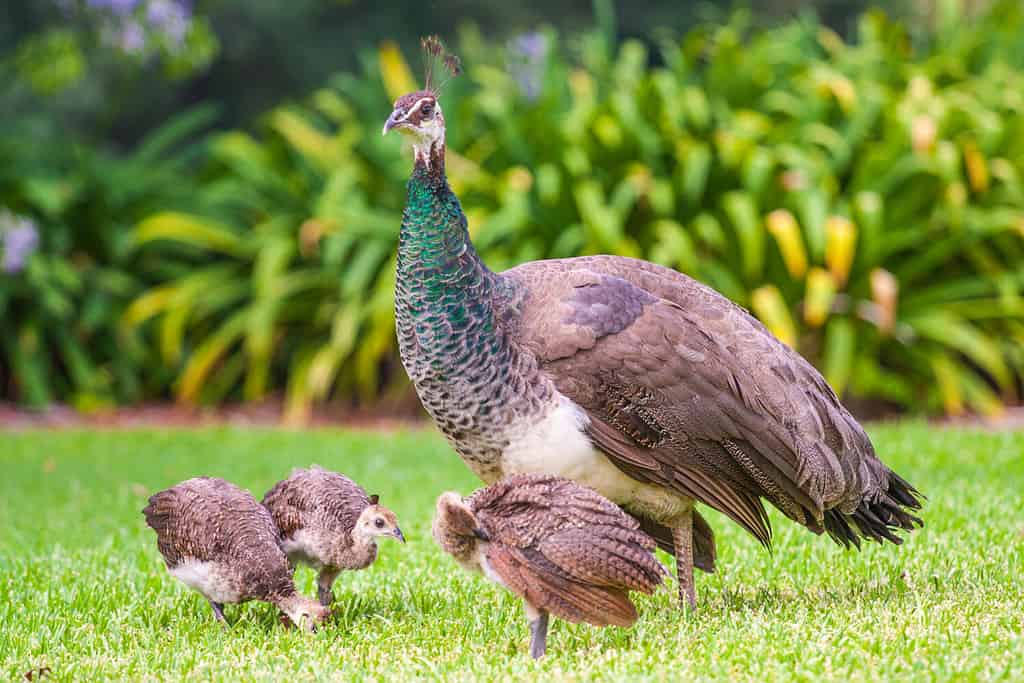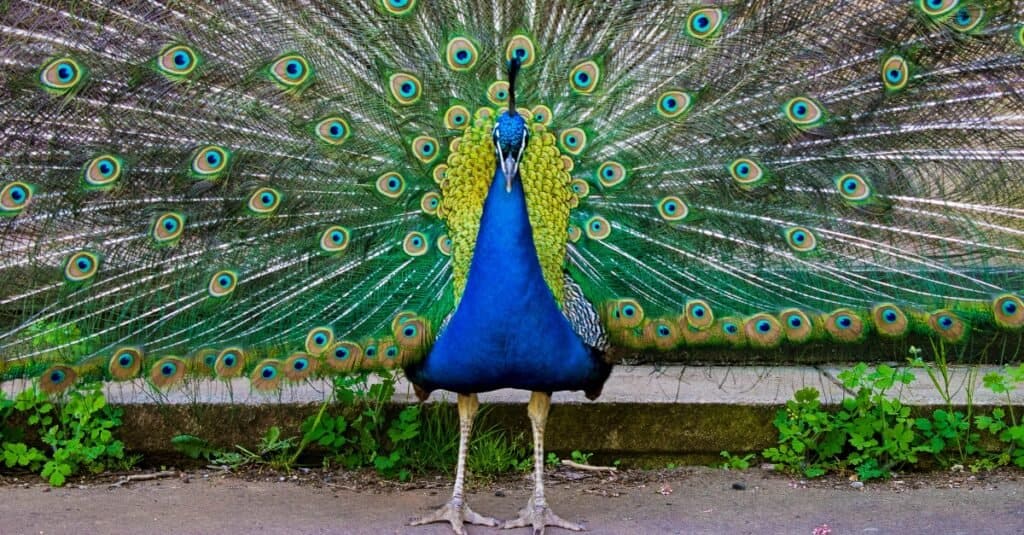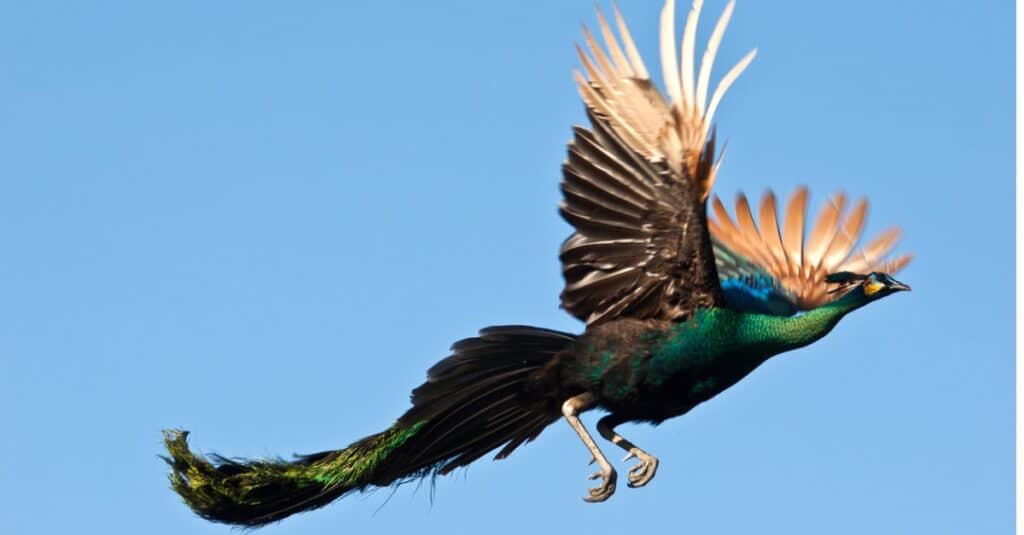The iridescent, metallic colors are mesmerizing and even have a spiritual meaning. But peacocks don’t just walk around with their feathers on full display all the time. They’re very intentional about it. Discover the reasons why peacocks spread their feathers! Plus, learn about these beautiful birds, including their courting and mating rituals and if they can fly.
Peacock Overview: What Is a Peacock?
The peacock is a bird that does not easily go unnoticed. It’s also called a peafowl though this term is rarely used. They make up part of the Phasianidae family. There are two well-known types of peacocks, and they include the blue peacock and the green peacock. The blue peacock is native to both Sri Lanka and India while the green peacock lives in Myanmar (Burma) and Java in Indonesia. There is a third species of peacock that lives in the Democratic Republic of the Congo. It was discovered in 1936.
These birds have gorgeous, elaborate colored plumage which they are famous for. However, this beautiful display is reserved for males only. The females have much shorter and plainer plumage and are called peahens. The males (called peacocks to distinguish them from the females) have distinctive metallic blue and green colors on their bodies and their body feathers. Peahens also have some green on their bodies mixed with brown, but their feathers are not nearly as long or mesmerizing.

Peahens have a much plainer appearance when compared to peacocks.
©PaxPhongTrinh/Shutterstock.com
Peacocks have a distinctive crest on their heads that has feathers that stand up. They also have a crown with blue feathers on their foreheads. These birds are very social and gather in groups. They are known for having a loud and piercing cry that can be easily recognized from far away. It kind of sounds like a human baby and can be used in several situations. For example, if a peacock is feeling territorial, it’ll use this scream to assert its dominance. When they’re ready to mate, they also employ this screeching call.
Peacock Courting and Mating
The beautiful feathery display of peacocks comes in handy when they’re looking for a mate. To impress a peahen and gain mating rights, a peacock spreads its feathers and starts vibrating them all. This creates a mesmerizing effect, with the eye-like patterns appearing still while the rest of the feathers rattle. It’s an eye-catching process that allows males to win over the attention of females.
It’s not just the beautiful display that captures peahens’ attention. Peacocks also start vocalizing loudly, screaming to attract the attention of any nearby females. As if screaming and displaying their beautiful feathers weren’t enough, peacocks must also perform a dance. They strut about and walk around in circles, letting the females know of their availability to mate.

Peacocks spread their feathers to communicate.
©iStock.com/Anna_Brothankova
During the breeding season, the males form a harem of three to five. The peahens are the ones that choose the male, which is why they have attractive plumage. The females later lay four to eight eggs, and 28 days later they hatch. The baby chicks arrive fully feathered from their eggs and only a week later they start trying to fly.
Although peahens take the responsibility of caring for their young on their own (without the assistance of the male), the newly emerged peachicks have a high rate of mortality. These birds possess fearless behavior and are aggressive, especially the peahens (mothers) when it comes to protecting their little ones. Those that survive become ready for mating at the age of two and some at the age of three.
Can Peacocks Fly?
Peacocks can fly but only for short distances and up to a height of eight feet. They are heavy birds, and males normally do a small flight before they start displaying their beautiful feathers. The flight is more like an ascend and a triumphant descend — this is how they flirt! As fearless as they are, they still take short flights to escape from predators. Just because they’re fearless doesn’t mean they are not cautious when danger is present.
Peacocks have heavy bodies, and their wings aren’t equipped to carry them for great distances. This is why you don’t frequently see these birds mid-flight. They primarily dwell on the ground. When they do manage to catch some air, they’re quite loud about it. They have to flap their wings rapidly, which is noisy. Since they can’t fly long distances, they’ve adapted to be good runners. If they need to get out of a situation, they can rely on their legs. However, when they’re relaxed in their environment, they walk and strut.

Peacocks can only fly for seconds at a time.
©iStock.com/charti1
Discover the Reasons Why Peacocks Spread Their Feathers
The reason peacocks spread their feathers is for courtship. It means the time has come for mating. But that is not the only reason they spread their feathers. They also do it when they prepare to defend themselves from intruders. Peahens also complete a feather display, but it is not as elaborate due to their shorter feathers and colors that are not as exotic. The females do a little dance and display in order to accept the future father of her peachicks. They each have their own way of communicating in preparation for baby-making.
There are some other reasons why peacocks spread their fathers, though the primary reason is related to courtship. For example, peacocks use the spreading of their feathers as a way to assert their dominance over their territory. This is particularly important if a nearby male is attempting to encroach on a peacock’s established territory. They walk out to their lek, which is their communal display area. They spread their feathers periodically to reinforce their dominance over their territory.
A peacock may also spread its feathers to show off just how healthy and strong it is. Peahens consider the genetic fitness of peacocks and are very selective of the mate they choose. When a peacock spreads its feathers, it’s like saying “Take a good look” to peahens. Ultimately, the peahens choose who they mate with and when they have all the information they need upfront, they can approach the eligible peacock and approve them as a mate.

Peacocks spread their feathers to ensure their ability to produce offspring.
©dangdumrong/Shutterstock.com
Although peacocks are the ones with the long, strikingly beautiful feathers, peahens also spread their feathers. They do this as a form of communication, particularly in response to a peacock that has caught their attention. When they’re interested, they approach the peacock and spread their own feathers, as if to say, “I choose you.”
Peacock Conservation
The beautiful display of peacocks unfortunately also captures the attention of poachers. Peacocks need their feathers as they use them as a means to communicate. They also employ them to assert their dominance and to protect themselves. Without them, they can’t attract a peahen to mate and reproduce. When poachers hunt them, they directly affect the species. They kill them to harvest their plumage — which is illegal. Due to humans interfering with the green peacock species, they are recognized as endangered. Hunting combined with habitat loss has resulted in this classification. The blue peacock is categorized as “least concern.” The Congo peacock is classified as a “vulnerable” species.
Fun Fact
White peacocks exist! These peacocks have a condition called Leucism, which is a genetic mutation. Peacocks are not naturally white. They occur most frequently in India and interestingly, when they hatch, they are not white. They’re actually yellow! But as they grow and mature, the yellow color drains from their feathers and they end up completely white from their bodies to their tail feathers.
The photo featured at the top of this post is © iStock.com/Robert Way
Thank you for reading! Have some feedback for us? Contact the AZ Animals editorial team.







